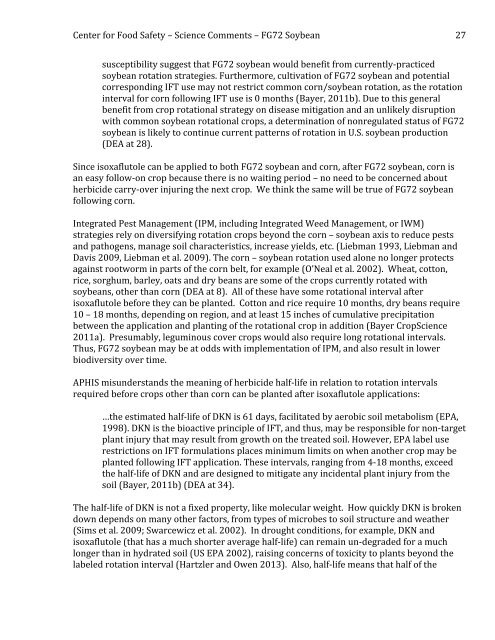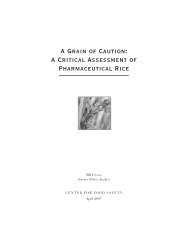a four-fold rise - Center for Food Safety
a four-fold rise - Center for Food Safety
a four-fold rise - Center for Food Safety
You also want an ePaper? Increase the reach of your titles
YUMPU automatically turns print PDFs into web optimized ePapers that Google loves.
<strong>Center</strong> <strong>for</strong> <strong>Food</strong> <strong>Safety</strong> – Science Comments – FG72 Soybean <br />
27 <br />
susceptibility suggest that FG72 soybean would benefit from currently-‐practiced <br />
soybean rotation strategies. Furthermore, cultivation of FG72 soybean and potential <br />
corresponding IFT use may not restrict common corn/soybean rotation, as the rotation <br />
interval <strong>for</strong> corn following IFT use is 0 months (Bayer, 2011b). Due to this general <br />
benefit from crop rotational strategy on disease mitigation and an unlikely disruption <br />
with common soybean rotational crops, a determination of nonregulated status of FG72 <br />
soybean is likely to continue current patterns of rotation in U.S. soybean production <br />
(DEA at 28). <br />
Since isoxaflutole can be applied to both FG72 soybean and corn, after FG72 soybean, corn is <br />
an easy follow-‐on crop because there is no waiting period – no need to be concerned about <br />
herbicide carry-‐over injuring the next crop. We think the same will be true of FG72 soybean <br />
following corn. <br />
Integrated Pest Management (IPM, including Integrated Weed Management, or IWM) <br />
strategies rely on diversifying rotation crops beyond the corn – soybean axis to reduce pests <br />
and pathogens, manage soil characteristics, increase yields, etc. (Liebman 1993, Liebman and <br />
Davis 2009, Liebman et al. 2009). The corn – soybean rotation used alone no longer protects <br />
against rootworm in parts of the corn belt, <strong>for</strong> example (O’Neal et al. 2002). Wheat, cotton, <br />
rice, sorghum, barley, oats and dry beans are some of the crops currently rotated with <br />
soybeans, other than corn (DEA at 8). All of these have some rotational interval after <br />
isoxaflutole be<strong>for</strong>e they can be planted. Cotton and rice require 10 months, dry beans require <br />
10 – 18 months, depending on region, and at least 15 inches of cumulative precipitation <br />
between the application and planting of the rotational crop in addition (Bayer CropScience <br />
2011a). Presumably, leguminous cover crops would also require long rotational intervals. <br />
Thus, FG72 soybean may be at odds with implementation of IPM, and also result in lower <br />
biodiversity over time. <br />
APHIS misunderstands the meaning of herbicide half-‐life in relation to rotation intervals <br />
required be<strong>for</strong>e crops other than corn can be planted after isoxaflutole applications: <br />
…the estimated half-‐life of DKN is 61 days, facilitated by aerobic soil metabolism (EPA, <br />
1998). DKN is the bioactive principle of IFT, and thus, may be responsible <strong>for</strong> non-‐target <br />
plant injury that may result from growth on the treated soil. However, EPA label use <br />
restrictions on IFT <strong>for</strong>mulations places minimum limits on when another crop may be <br />
planted following IFT application. These intervals, ranging from 4-‐18 months, exceed <br />
the half-‐life of DKN and are designed to mitigate any incidental plant injury from the <br />
soil (Bayer, 2011b) (DEA at 34). <br />
The half-‐life of DKN is not a fixed property, like molecular weight. How quickly DKN is broken <br />
down depends on many other factors, from types of microbes to soil structure and weather <br />
(Sims et al. 2009; Swarcewicz et al. 2002). In drought conditions, <strong>for</strong> example, DKN and <br />
isoxaflutole (that has a much shorter average half-‐life) can remain un-‐degraded <strong>for</strong> a much <br />
longer than in hydrated soil (US EPA 2002), raising concerns of toxicity to plants beyond the <br />
labeled rotation interval (Hartzler and Owen 2013). Also, half-‐life means that half of the







